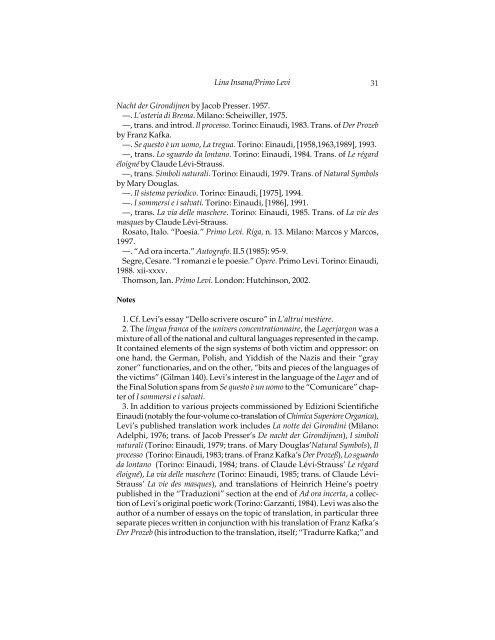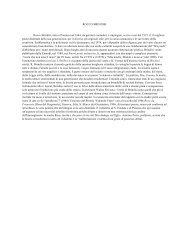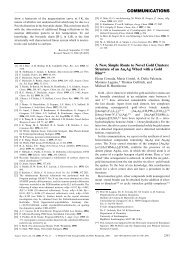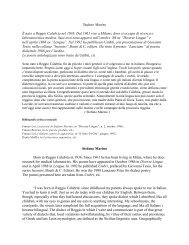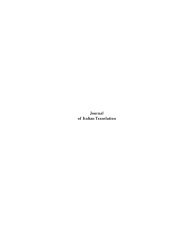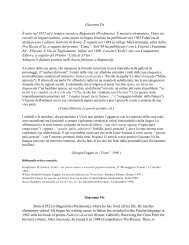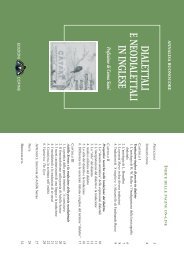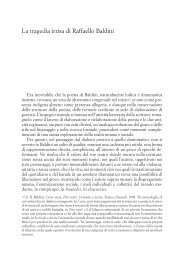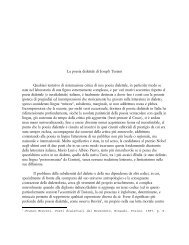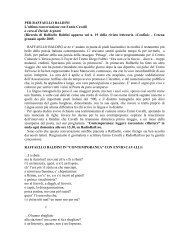Journal of Italian Translation
Journal of Italian Translation
Journal of Italian Translation
You also want an ePaper? Increase the reach of your titles
YUMPU automatically turns print PDFs into web optimized ePapers that Google loves.
Lina Insana/Primo Levi<br />
Nacht der Girondijnen by Jacob Presser. 1957.<br />
—. L’osteria di Brema. Milano: Scheiwiller, 1975.<br />
—, trans. and introd. Il processo. Torino: Einaudi, 1983. Trans. <strong>of</strong> Der Prozeb<br />
by Franz Kafka.<br />
—. Se questo è un uomo, La tregua. Torino: Einaudi, [1958,1963,1989], 1993.<br />
—, trans. Lo sguardo da lontano. Torino: Einaudi, 1984. Trans. <strong>of</strong> Le régard<br />
éloigné by Claude Lévi-Strauss.<br />
—, trans. Simboli naturali. Torino: Einaudi, 1979. Trans. <strong>of</strong> Natural Symbols<br />
by Mary Douglas.<br />
—. Il sistema periodico. Torino: Einaudi, [1975], 1994.<br />
—. I sommersi e i salvati. Torino: Einaudi, [1986], 1991.<br />
—, trans. La via delle maschere. Torino: Einaudi, 1985. Trans. <strong>of</strong> La vie des<br />
masques by Claude Lévi-Strauss.<br />
Rosato, Italo. “Poesia.” Primo Levi. Riga, n. 13. Milano: Marcos y Marcos,<br />
1997.<br />
—. “Ad ora incerta.” Autografo. II.5 (1985): 95-9.<br />
Segre, Cesare. “I romanzi e le poesie.” Opere. Primo Levi. Torino: Einaudi,<br />
1988. xii-xxxv.<br />
Thomson, Ian. Primo Levi. London: Hutchinson, 2002.<br />
Notes<br />
1. Cf. Levi’s essay “Dello scrivere oscuro” in L’altrui mestiere.<br />
2. The lingua franca <strong>of</strong> the univers concentrationnaire, the Lagerjargon was a<br />
mixture <strong>of</strong> all <strong>of</strong> the national and cultural languages represented in the camp.<br />
It contained elements <strong>of</strong> the sign systems <strong>of</strong> both victim and oppressor: on<br />
one hand, the German, Polish, and Yiddish <strong>of</strong> the Nazis and their “gray<br />
zoner” functionaries, and on the other, “bits and pieces <strong>of</strong> the languages <strong>of</strong><br />
the victims” (Gilman 140). Levi’s interest in the language <strong>of</strong> the Lager and <strong>of</strong><br />
the Final Solution spans from Se questo è un uomo to the “Comunicare” chapter<br />
<strong>of</strong> I sommersi e i salvati.<br />
3. In addition to various projects commissioned by Edizioni Scientifiche<br />
Einaudi (notably the four-volume co-translation <strong>of</strong> Chimica Superiore Organica),<br />
Levi’s published translation work includes La notte dei Girondini (Milano:<br />
Adelphi, 1976; trans. <strong>of</strong> Jacob Presser’s De nacht der Girondijnen), I simboli<br />
naturali (Torino: Einaudi, 1979; trans. <strong>of</strong> Mary Douglas’Natural Symbols), Il<br />
processo (Torino: Einaudi, 1983; trans. <strong>of</strong> Franz Kafka’s Der Prozeß), Lo sguardo<br />
da lontano (Torino: Einaudi, 1984; trans. <strong>of</strong> Claude Lévi-Strauss’ Le régard<br />
éloigné), La via delle maschere (Torino: Einaudi, 1985; trans. <strong>of</strong> Claude Lévi-<br />
Strauss’ La vie des masques), and translations <strong>of</strong> Heinrich Heine’s poetry<br />
published in the “Traduzioni” section at the end <strong>of</strong> Ad ora incerta, a collection<br />
<strong>of</strong> Levi’s original poetic work (Torino: Garzanti, 1984). Levi was also the<br />
author <strong>of</strong> a number <strong>of</strong> essays on the topic <strong>of</strong> translation, in particular three<br />
separate pieces written in conjunction with his translation <strong>of</strong> Franz Kafka’s<br />
Der Prozeb (his introduction to the translation, itself; “Tradurre Kafka;” and<br />
31


